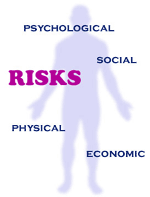 When conducting an evaluation, we are required to minimize the risks to participants; however we sometimes struggle to identify what those risks may be and how they relate to any potential benefits. Particularly when the study involves issues like the arts, academic achievement or interest in extra-curricular activities, the risks may seem very remote or negligible.
However, professional ethics demands that we fairly weight these risks and be honest with participants about what the risks may be. A training from the National Cancer Institute helped us to define these risks recently. Risks to individuals are classified as physical, psychological, social, legal, and economic. In the process of determining what constitutes a risk, only those risks that may result from the research, as distinguished from those associated with therapies participants would undergo even if not engaged in research, should be considered.
In our work, the most apparent risks are psychological or social. We must be careful that the participants in our evaluation studies do not suffer any social stigma from their participation. Also, we must be careful when wording questions and designing evaluation studies that the process is not traumatic in any way for participants.
When conducting an evaluation, we are required to minimize the risks to participants; however we sometimes struggle to identify what those risks may be and how they relate to any potential benefits. Particularly when the study involves issues like the arts, academic achievement or interest in extra-curricular activities, the risks may seem very remote or negligible.
However, professional ethics demands that we fairly weight these risks and be honest with participants about what the risks may be. A training from the National Cancer Institute helped us to define these risks recently. Risks to individuals are classified as physical, psychological, social, legal, and economic. In the process of determining what constitutes a risk, only those risks that may result from the research, as distinguished from those associated with therapies participants would undergo even if not engaged in research, should be considered.
In our work, the most apparent risks are psychological or social. We must be careful that the participants in our evaluation studies do not suffer any social stigma from their participation. Also, we must be careful when wording questions and designing evaluation studies that the process is not traumatic in any way for participants.
 When conducting an evaluation, we are required to minimize the risks to participants; however we sometimes struggle to identify what those risks may be and how they relate to any potential benefits. Particularly when the study involves issues like the arts, academic achievement or interest in extra-curricular activities, the risks may seem very remote or negligible.
However, professional ethics demands that we fairly weight these risks and be honest with participants about what the risks may be. A training from the National Cancer Institute helped us to define these risks recently. Risks to individuals are classified as physical, psychological, social, legal, and economic. In the process of determining what constitutes a risk, only those risks that may result from the research, as distinguished from those associated with therapies participants would undergo even if not engaged in research, should be considered.
In our work, the most apparent risks are psychological or social. We must be careful that the participants in our evaluation studies do not suffer any social stigma from their participation. Also, we must be careful when wording questions and designing evaluation studies that the process is not traumatic in any way for participants.
When conducting an evaluation, we are required to minimize the risks to participants; however we sometimes struggle to identify what those risks may be and how they relate to any potential benefits. Particularly when the study involves issues like the arts, academic achievement or interest in extra-curricular activities, the risks may seem very remote or negligible.
However, professional ethics demands that we fairly weight these risks and be honest with participants about what the risks may be. A training from the National Cancer Institute helped us to define these risks recently. Risks to individuals are classified as physical, psychological, social, legal, and economic. In the process of determining what constitutes a risk, only those risks that may result from the research, as distinguished from those associated with therapies participants would undergo even if not engaged in research, should be considered.
In our work, the most apparent risks are psychological or social. We must be careful that the participants in our evaluation studies do not suffer any social stigma from their participation. Also, we must be careful when wording questions and designing evaluation studies that the process is not traumatic in any way for participants.
